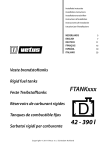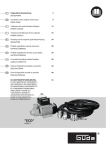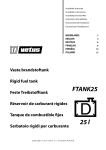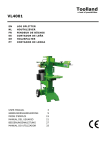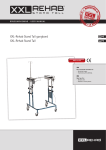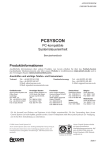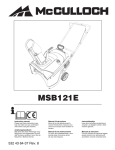Download Brandstof-overloop Splash-Stop Treibstoff-Überlauf
Transcript
Installatie instructies Installation instructions Installationsvorschriften Instructions d’installation Instrucciones de instalación Istruzioni per l’installazione NEDERLANDS ENGLISH DEUTSCH FRANÇAIS ESPAÑOL ITALIANO 2 4 6 8 10 12 Brandstof-overloop Splash-Stop Treibstoff-Überlauf Splash stop pour gas-oil Rebosadero de carburante Interruttore di flusso per carburante C o p y r i g h t © 2 0 0 5 Ve t u s d e n O u d e n n . v. S c h i e d a m H o l l a n d FS3816 FS5116 FS5119 FS5122 FS5125 Inleiding De Vetus brandstof-overloop voorkomt dat brandstof uit de tank via de vuldop overloopt en op het dek terecht komt. Overlopen van de brandstof kan gebeuren tijdens het vullen als de tank vrijwel vol is of als de brandstoftank gevuld is met zeer koude brandstof, uit een ondergrondse tank, terwijl de omgevingstemperatuur van de tank aan boord hoog is. De brandstof zal dan tijdens het opwarmen uitzetten! De uit de tank overlopende brandstof wordt in een 2 liter groot reservoir opgevangen. Dit reservoir zal uiteindelijk via de ontluchtingsleiding in de brandstoftank leeg lopen. Het schot moet bij voorkeur zodanig schuin staan dat de vulbuis in de brandstof-overloop 10˚ of meer aflopend schuin is opgesteld. De werking van de brandstof-overloop wordt sterk verbeterd indien gebruik wordt gemaakt van een vulpistool met automatische afslag. FS3816/ FS5116: Indien een slang van ø 51 mm wordt aangesloten, dient de aansluiting voor slang ø 38 mm te worden afgezaagd. Braam het zaagvlak goed af. Verwijder eventueel zaagsel uit de brandstofoverloop. Gebruik Plaats eerst het vulpistool zo ver mogelijk in de interne vulbuis (door de rubberflappen van de anti-spat mof) van de brandstofoverloop, bedien dan het vulpistool om de tank te vullen. Afbramen Afzagen ø38 (1.5") ø51 (2") WAARSCHUWING Brandstof is schadelijk voor het millieu. Voorkom morsen van brandstof! Houdt olieabsorberende doeken gereed als voorzorgsmaatregel! Installatie Algemeen Bepaal een geschikte plaats voor de brandstof-overloop en de vuldop. De brandstof-overloop is geschikt om te worden toegepast met zowel een in het dek geplaatste vuldop als met een in een schot (vertikaal vlak) geplaatste vuldop. De brandstof-overloop FS3816 is alleen toepasbaar in combinatie met: - de Vetus dekdop voor diesel ø 38 mm - de Vetus dekdop voor ‘unleaded gasoline’ (benzine) ø 38 mm - een dekdop met een uitwendige diameter van ø 37,7 mm tot ø 38,3 mm De brandstof-overloop FS5116/ FS5119/ FS5122/ FS5125 is alleen toepasbaar in combinatie met: - de Vetus dekdop voor diesel ø 51 mm - een dekdop met een uitwendige diameter van ø 51 mm tot ø 52,8 mm 2 040402.02 WAARSCHUWING Plaats de vuldop nooit in een afgesloten ruimte, gemorste brandstof kan dan in het schip terechtkomen ! Indien als brandstof benzine (in plaats van dieselolie) wordt toegepast dient de brandstof-overloop in een zeer goed geventileerde ruimte te worden opgesteld! De slangaansluitingen van de brandstof-overloop moeten tijdens de montage goed toegankelijk zijn, houdt hier rekening mee bij het kiezen van de plaats voor de brandstof-overloop en de vuldop. Ook voor controle en eventueel onderhoud is een goede toegankelijkheid van belang. Indien de vuldop in een vertikaal vlak is gemonteerd dan moet het kleine ontluchtingsgat in de anti-spatmof zich op het laagste punt bevinden. Brandstof-overloop NEDERLANDS Monteer de ontluchtingsleiding, pas hiervoor een brandstofbestendige slang met een inwendige diameter van 16, 19, 22 of 25 mm toe (afhankelijk van de uitvoering). Montage Het eerste stuk ontluchtingsleiding, tevens retourleiding voor de in de brandstof-overloop opgevangen brandstof, dient van de tank naar de aansluiting ‘RETURN’ te worden gevoerd. Het tweede stuk ontluchtingsleiding dient van de aansluiting ‘VENT’ naar de ontluchtingsnippel te worden gevoerd. Monteer de vuldop. De slangaansluiting van de vuldop dient zo kort mogelijk te zijn, kort indien noodzakelijk de slangaansluiting in. De ontluchtingsleiding dient, vanaf de tank tot aan het geurfilter of de zwanehals, voortdurend in hoogte oplopend te worden gemonteerd. Monteer alle slangverbindingen met 2 RVS slangklemmen! De brandstof-overloop is aan de bovenzijde voorzien van een aansluiting voor de ontluchtingsleiding. Deze aansluiting is circa 200˚ draaibaar. Monteer de brandstof-overloop met de reeds voorgemonteerde rubbermof en de meegeleverde slangklem op de vuldop. Gebruik eventueel water of zeep; geen olie. Ondersteun de brandstofoverloop door de meegeleverde strip aan het dek of het gangboord vast te maken. De strip kan zowel links als rechts aangebracht worden. Monteer een vulslang tussen de brandstof-overloop en de tank, pas hiervoor een brandstofbestendige slang met een inwendige diameter van 38 mm resp. 51 mm toe. Installeer deze slang zodanig dat zowel de tank als de brandstofoverloop niet mechanisch worden belast. Plaats de ontluchtingsnippel, zo hoog mogelijk, boven het niveau van de brandstof-overloop. Uittrede van brandstof uit de ontluchting wordt hiermee voorkomen. WAARSCHUWING Kies een zodanige plaats voor de ontluchtingsnippel dat dampen niet in het schip terecht kunnen komen! Via de ontluchtingsnippel kunnen onaangename geuren vrijkomen. Dit is te voorkomen door het installeren van een actief koolfilter (Vetus geurfilter) in de ontluchtingsleiding. Raadpleeg de bijbehorende handleiding voor installatie van het Vetus geurfilter. Het Vetus geurfilter is alleen geschikt voor diesel, niet voor benzine. Brandstof-overloop FS3816 FS5116 FS5122 FS5119 FS5125 De dekfitting en de andere metalen delen die in aanraking kunnen komen met de brandstof moeten geaard worden om vonken ten gevolge van statische electriciteit te voorkomen. Toe te passen draaddoorsnede tenminste 1 mm2, kleur van de isolatie groen/geel. Onderhoud Controleer regelmatig de ontluchtingsnippel en reinig de zeef van de ontluchtingsnippel indien noodzakelijk. Controleer jaarlijks: - de anti-spatmof en vervang deze indien noodzakelijk. - de slangen en slangverbindingen op mogelijke lekkage en monteer nieuwe slangen en/of slangklemmen indien noodzakelijk. Technische gegevens Inhoud reservoir : 2 liter Materiaal : Polyetheen Gewicht : 1,3 kg FS3816 FS5116 FS5119 FS5122 FS5125 Aansluitingen Dekdop Vulslang ø 38 ø 38 / ø 51 ø 51 ø 51 Ontluchting ø 16 ø 19 ø 22 ø 25 040402.02 3 Introduction The Vetus Splash-Stop prevents fuel from overflowing onto the deck out of the filler cap. Fuel overflow may occur during filling when the tank is nearly full or when the tank is filled with very cold fuel from an underground tank while the temperature on board is relatively high. The fuel will then expand as it warms up! Frothing fuel overflows into a 2 litre reservoir. This reservoir is eventually emptied into the fuel tank through the breather line. The Splash-stop works much better if a nozzle with automatic cut-off is used. Use First place the filling nozzle as far as possible into the SplashStop opening (through the rubber flaps of the anti-splash sleeve). Use the nozzle to fill the tank. The bulkhead should be diagonal so that the Splash-Stop’s filler cap is at a minimum angle of 10˚. FS3816/ FS5116: If a ø 51 mm hose is connected, the connection for the ø 38 mm hose should be sawn off. Trim the sawn surface well. Remove any sawdust from the Splash-stop. Remove burrs Saw off ø38 (1.5") ø51 (2") WARNING Fuel is harmful to the environment. Prevent any spilling! Keep oil-absorbent rags within reach as a precaution! Installation General Choose an appropriate position for the Splash-Stop and the deck plate. The Splash-Stop can be installed with the deck plate mounted either on the deck or in a bulkhead (vertical surface). The Splash-stop FS3816 can only be applied in combination with: - the Vetus deck cap for diesel ø 38 mm - the Vetus deck cap for ‘unleaded gasoline’ (petrol) ø 38 mm - a deck cap with an external diameter of ø 37.7 mm to ø 38.3 mm. The Splash-stop FS5116/ FS5119/ FS5122/ FS5125 can only be applied in combination with: - the Vetus deck cap for diesel ø 51 mm - a deck cap with an external diameter of ø 51 mm to ø 52.8 mm. 4 040402.02 WARNING Never place the filler cap in a closed space. Fuel could then be spilled inside the ship! If petrol is used instead of diesel, the Splash-Stop must be located in a well-ventilated area! The connecting hoses must be easily accessible during installation, take this into account when choosing the location of the Splash-Stop and filler cap. Easy access is also important for maintenance and repairs. If the filler cap has been placed in a vertical surface, then the small breather hole in the anti-splash sleeve must be fitted at the lowest point. Splash-Stop ENGLISH Fit the breather hose using fireproof hose with a 16, 19, 22 or 25 mm inner diameter, depending on the version. Assembly The first section of the breather hose, which is also the feed for fuel caught in the Splash-Stop, should run from the tank to the RETURN connection. The second section of breather hose should be run from the VENT connection to the breather nipple. Assemble the filler cap. The hose connection must be as short as possible; shorten the hose connection as necessary. The breather hose must be fitted such that there is a continuous upward slope in relation to the tank. Fasten all hose connections with 2 stainless steel hose clamps! The top side of the Splash-stop is equipped with a connection for the breather line. This connection has a turning radius of about 200°. Fit the Splash-stop onto the filler cap with the pre-fitted rubber sleeve and the hose clamp included. Use water or soap, if needed; do not use oil. Support the Splash-stop by attaching the strip provided to the deck or the gangway. The strip can be fitted on both sides of the splash-stop. Fit a filler hose between the Splash-Stop and the tank. Use fireproof hose with a 38 mm or 51 mm inner diameter respectively. Place it such that no mechanical stress is placed on either the tank or the Splash-Stop. Place the breather nipple as high as possible above the level of the Splash-Stop. This will prevent fuel escaping from the breather lines. FS3816 FS5116 FS5122 FS5119 FS5125 The deck fitting and the other metal parts that may come in contact with the fuel, must be grounded to prevent sparks from static electricity. Use a wire cross-section of 1 mm2 minimal, insulation colour green/yellow. Maintenance Check the breather nipple regularly and clean the steel breather nipple strainer whenever necessary. Check annually: - the anti-splash sleeve and replace when necessary. - the hoses and hose connections for possible leakage and replace hoses and hose clamps when necessary. Technical information WARNING Choose a location for the breather nipple such that fumes are not trapped within the ship! Unpleasant odours can escape through the breather nipple. This can be prevented by fitting an active carbon filter (the Vetus Odour filter) onto the breather line. Refer to the relevant instruction manual for installation of the Vetus Odour filter. The Vetus Odour filter is only suitable for diesel, not petrol. Splash-Stop Reservoir volume Material Weight FS3816 FS5116 FS5119 FS5122 FS5125 : 2 litres : Polyethylene : 1.3 kg Connections Filler cap Filler hose ø 38 ø 38 / ø 51 ø 51 ø 51 Breather hose ø 16 ø 19 ø 22 ø 25 040402.02 5 Einleitung Der Vetus Treibstoff-Überlauf verhindert, daß Treibstoff aus dem Tank über den Einfüllstutzen überläuft und auf das Deck gerät. Der Tank kann überlaufen, wenn er nahezu voll oder mit äußerst kaltem Treibstoff, aus einem Erdtank, gefüllt ist, während die Umgebungstemperatur des Tanks an Bord hoch ist. Der Treibstoff dehnt sich beim Erwärmen aus! Der aus dem Tank überlaufende Treibstoff wird in einem Reservoir mit einem Inhalt von 2 Litern aufgefangen. Der Treibstoff fließt schließlich aus diesem Reservoir über die Entlüftungsleitung wieder in den Treibstofftank zurück. Der Treibstoff-Überlauf arbeitet bedeutend besser, wenn eine Zapfpistole mit automatischem Stopp benutzt wird. Benutzung Den Zapfhahn zuerst soweit wie möglich in den internen Einfüllstutzen (durch den Gummischutz des Antispritzmuffs) des Treibstoff-Überlaufs einführen, dann den Füllhahn bedienen, um den Tank zu füllen. Die Wand sollte vorzugsweise so schräg stehen, daß der Einfüllschlauch im Treibstoff-Überlauf 10˚ oder mehr nach unten hin schräg ablaufend angebracht werden kann. FS3816 / FS5116: Abgraten Wenn ein Schlauch mit einem Durchmesser von 51 mm angeschlossen wird, Absägen muß der Anschluß für einen Schlauch mit 38 mm Durchmesser abgesägt ø38 (1.5") ø51 (2") werden. Graten Sie die abgesägten Stellen gut ab und entfernen Sie eventuelle Späne aus dem Treibstoff-Überlauf. WARNUNG Treibstoff ist umweltschädlich. Vermeiden Sie das Verschütten von Treibstoff! Vorsichtshalber ölabsorbierende Lappen bereit halten! Installation Allgemeines Eine geeignete Stelle für den Treibstoff-Überlauf und den Einfüllstutzen ermitteln. Der Treibstoff-Überlauf kann sowohl mit einem im Deck angebrachten Einfüllstutzen als auch mit einem in einer Wand (vertikale Oberfläche) angebrachten Einfüllstutzen benutzt werden. Der Treibstoff-Überlauf FS3816 ist nur zu gebrauchen in Kombination mit: - dem Vetus Deckstutzen für Diesel mit einem Durchmesser von 38 mm - dem Vetus Deckstutzen für ‘Unleaded Gasoline’ mit einem Durchmesser von 38 mm - einem Deckstutzen mit einem Außendurchmesser von 37,7 mm bis 38,3 mm Der Treibstoff-Überlauf FS5116/ FS5119/ FS5122/ FS5125 ist nur zu gebrauchen in Kombination mit: - dem Vetus Deckstutzen für Diesel mit einem Durchmesser von 51 mm - einem Deckstutzen mit einem Außendurchmesser von 51 mm bis 52,8 mm 6 040402.02 WARNUNG Den Einfüllstutzen keinesfalls in einem geschlossenen Raum anbringen, verschütteter Treibstoff kann dann in das Schiff gelangen! Sollte als Treibstoff Benzin verwendet werden (anstatt Dieselöl), ist der Treibstoff-Überlauf in einem gut gelüfteten Raum zu installieren! Die Schlauchanschlüsse des Treibstoff-Überlaufs müssen während der Montage gut zugänglich sein, berücksichtigen Sie dies bei der Wahl der Stelle für den Treibstoff-Überlauf und den Einfüllstutzen. Auch zu Kontrollzwecken und für eventuelle Wartungsarbeiten ist eine gute Zugänglichkeit wichtig. Sollte der Einfüllstutzen in eine vertikale Oberfläche montiert werden, so muß sich die kleine Entlüftungsöffnung im Antispritzmuff an der niedrigsten Stelle befinden. Treibstoff-Überlauf DEUTSCH Die Entlüftungsleitung montieren, dafür einen treibstoffbeständigen Schlauch mit einem Innendurchmesser von 16, 19, 22 oder 25 mm verwenden, abhängig von der Ausführung. Montage Das erste Stück der Entlüftungsleitung, zugleich auch die Rückführleitung für den im Treibstoff-Überlauf aufgefangenen Treibstoff, muß vom Tank zum ‘RETURN’-Anschluß geführt werden. Das zweite Stück der Entlüftungsleitung muß vom ‘VENT’Anschluß zum Entlüftungsnippel geführt werden. Montage des Einfüllstutzens. Der Schlauchanschluß des Einfüllstutzens sollte möglichst kurz sein und ist nötigenfalls zu verkürzen. Die Entlüftungsleitung muß vom Tank bis zum Geruchsfilter oder Schwanenhals immer nach oben montiert werden. Alle Schlauchverbindungen mit 2 Schlauchklemmen aus rostfreiem Stahl befestigen! Die Verschlußfassung und andere Metallteile, die mit dem An der Oberseite des TreibstoffÜberlaufs befindet sich ein Anschluß für die Entlüftungsleitung. Dieser Anschluß läßt sich circa 200° drehen. Montieren Sie den Treibstoff-Überlauf mit dem bereits montierten Gummimuff und der mitgelieferten Schlauchklemme auf den Einfüllstutzen. Verwenden Sie eventuell Wasser oder Seife, kein Öl. Als Unterstützung den Treibstoff-Überlauf mit dem mitgelieferten Strip am Deck oder am Gangbord befestigen. Der Strip kann sowohl links als auch rechts angebracht werden. Zwischen dem Treibstoff-Überlauf und dem Tank einen Einfüllschlauch montieren. Dafür einen treibstoffbeständigen Schlauch mit einem Innendurchmesser von 38 mm bzw. 51 mm verwenden. Diesen Schlauch so anbringen, daß sowohl der Tank als auch der Treibstoff-Überlauf nicht mechanisch belastet werden. Den Entlüftungsnippel möglichst weit oberhalb des Niveaus des Treibstoff-Überlaufs anbringen. Damit wird verhindert, daß Treibstoff aus der Entlüftung entweicht. WARNUNG Für den Entlüftungsnippel eine Stelle wählen, an der keine Dämpfe in das Schiff geraten können! Über den Entlüftungsnippel können unangenehme Gerüche freiwerden. Die Installation eines Aktivkohlefilters (VetusGeruchsfilter) in der Entlüftungsleitung ist das beste Mittel hiergegen. Zur Installation des Vetus-Geruchsfilters die entsprechende Anleitung zu Rate ziehen. Der Vetus Geruchsfilter ist ausschließlich für Diesel und nicht für Benzin geeignet. Treibstoff-Überlauf FS3816 FS5116 FS5122 FS5119 FS5125 Treibstoff in Berührung kommen können, müssen geerdet werden, um Funkenbildung aufgrund statischer Elektrizität zu vermeiden. Zu verwendender Drahtdurchmesser mindestens 1 mm2, Farbe der Isolation grün/gelb. Wartung Regelmäßig den Entlüftungsnippel überprüfen und nötigenfalls das Sieb des Entlüftungsnippels reinigen. Jährlich kontrollieren: - den Antispritzmuff, nötigenfalls austauschen. - die Schläuche und Schlauchverbindung auf mögliche Leckagen und nötigenfalls neue Schläuche und/oder Schlauchverbindungen montieren Technische Daten Inhalt Reservoir Material Gewicht FS3816 FS5116 FS5119 FS5122 FS5125 : 2 Liter : Polyäthen : 1,3 kg Anschlüsse Einfullstutzen Einfüllschlauch ø 38 ø 38 / ø 51 ø 51 ø 51 Entlüftung ø 16 ø 19 ø 22 ø 25 040402.02 7 Introduction Le splash stop Vetus empêche que le carburant ne ressorte du réservoir via l’entrée de remplissage et n’atteigne le pont. Il peut y avoir refoulement de carburant au remplissage, si le réservoir est presque plein ou s’il est rempli de carburant très froid provenant d’un réservoir souterrain, alors que le réservoir à bord se trouve dans une température ambiante élevée. En se réchauffant, le carburant va se dilater! Le carburant ressortant du réservoir est recueilli dans un réservoir d’une capacité de 2 litres. Ce réservoir se videra finalement dans le réservoir de carburant via l’évent. La cloison doit de préférence être inclinée de telle sorte que le tube de remplissage dans le splash stop ait une inclinaison de 10˚ ou plus. Le fonctionnement du splash stop est fortement amélioré si l’on utilise un pistolet de remplissage à arrêt automatique. FS3816/ FS5116: Si l’on raccorde un tuyau ø 51 mm, il faut scier la connexion pour le tuyau ø 38 mm. Ebarber soigneusement la surface sciée. Enlever la sciure éventuelle du splash stop. Utilisation Placer d’abord le pistolet de remplissage aussi loin que possible dans le tube de remplissage interne du splash stop (dans les rabats en caoutchouc du manchon anti-projections), actionner alors le pistolet pour remplir le réservoir. AVERTISSEMENT Les carburants polluent l’environnement. Eviter les éclaboussures! Par mesure de précaution, conserver toujours sous la main des chiffons absorbant le gas-oil! Installation Généralités Choisir un emplacement adéquat pour le splash stop et l’entrée. Le splash stop peut être utilisé aussi bien avec une entrée placée dans le pont qu’avec une entrée dans une cloison (plan vertical). Le splash stop FS3816 doit être utilisé uniquement en combinaison avec: - le bouchon de pont Vetus pour gas-oil ø 38 mm - le bouchon de pont Vetus pour ‘unleaded gasoline’ ø 38 mm - un bouchon de pont ayant un diamètre extérieur compris entre ø 37,7 mm et ø 38,3 mm. Le splash stop FS1616/ FS5119/ FS5122/ FS5125 doit être utilisé uniquement en combinaison avec: - le bouchon de pont Vetus pour gas-oil ø 51 mm - un bouchon de pont ayant un diamètre extérieur compris entre ø 51 mm et ø 52,8 mm. 8 040402.02 Ebarber Scier ø38 (1.5") ø51 (2") AVERTISSEMENT Ne jamais placer l’entrée dans une enceinte fermée, du carburant pourrait tomber dans le bateau! Si l’on utilise comme carburant de l’essence (au lieu de gasoil), on devra placer le splash stop dans un lieu très bien aéré! Les connexions de tuyaux du splash stop devront être parfaitement accessibles pendant le montage; en tenir compte lors du choix de l’emplacement du splash stop et de l’entrée. Une bonne accessibilité des pièces est importante également pour les contrôles et l’entretien éventuel. Si l’entrée est montée dans un plan vertical, le petit orifice de mise à l’air dans le manchon anti-projections devra alors se trouver au point le plus bas. Splash stop pour gas-oil FRANÇAIS Monter l’évent, utiliser à cette fin un tuyau résistant aux carburants ayant un diamètre interne de 16, 19, 22 ou 25 mm, selon le modèle. Montage Le premier élément d’évent, qui sert en outre de tuyau-retour pour le carburant recueilli dans le splash stop, doit conduire du réservoir à la connexion ‘RETURN’. Le deuxième élément d’évent doit conduire de la connexion ‘VENT’ à la douille de prise d’air. Monter l’entrée du remplissage. La connexion de tuyau de l’entrée doit être aussi courte que possible, raccourcir la connexion de tuyau si cela est nécessaire. Le splash stop est doté à la partie supérieure d’une con-nexion pour l’évent. Cette connexion peut tourner d’environ 200˚. L’évent doit être monté depuis le réservoir jusqu’au filtre antiodeur ou au col-de-cygne avec une hauteur qui va toujours en augmentant. Monter tous les raccords de tuyaux avec 2 colliers de serrage en acier inoxydable! FS3816 FS5116 FS5122 FS5119 FS5125 Monter le splash stop sur l’entrée avec le manchon en caoutchouc déjà prémonté et le collier de serrage livré avec l’appareil. Utiliser éventuellement de l’eau ou du savon, mais pas d’huile. La garniture de pont et les autres pièces métalliques pouvant entrer en contact avec le carburant doivent être mises à la terre pour éviter les étincelles en conséquence de l’électricité statique. Section de fil à utiliser 1 mm2 au moins, couleur de l’isolation vert/jaune. Soutenir le splash stop en fixant la plaquette fournie sur le pont ou à la coursive. La plaquette peut être montée à droite ou à gauche. Entretien Monter un tuyau de remplissage entre le splash stop et le réservoir, utiliser pour cela un tuyau résistant aux carburants ayant un diamètre interne de 38 mm respectivement 51 mm. Installer ce tuyau de façon à ne pas solliciter mécaniquement ni le réservoir ni le splash stop. Placer la douille de prise d’air, aussi haut que possible, audessus du niveau du splash stop. On empêche ainsi que le carburant ne sorte de la prise d’air. AVERTISSEMENT Pour la douille de prise d’air, choisir un emplacement tel que les vapeurs ne puissent pénétrer dans le bateau! Des odeurs déplaisantes peuvent s’échapper de la douille de prise d’air. L’installation d’un filtre au charbon actif (Filtre antiodeur Vetus) dans l’évent permet de remédier à ce problème. Consulter à cet effet le manuel d’installation du filtre anti-odeur de gas-oil Vetus. Le filtre anti-odeur de Vetus convient uniquement pour le diesel, pas pour l’essence. Splash stop pour gas-oil Contrôler régulièrement la douille de prise d’air et nettoyer le tamis de la douille de prise d’air si cela est nécessaire. Contrôler une fois par an: - le manchon anti-projections et le remplacer si cela est nécessaire. - les tuyaux et raccords de tuyaux (fuites éventuelles) et monter de nouveaux tuyaux et/ou colliers de serrage si cela est nécessaire. Fiche technique Capacité du réservoir Matière Poids : 2 litres : Polyéthylène : 1,3 kg Connexions Entrée du remplissage Tuyau de remplissage Prise d’air FS3816 ø 38 ø 38 / ø 51 ø 16 FS5116 FS5119 ø 19 ø 51 FS5122 ø 51 ø 22 FS5125 ø 25 040402.02 9 Introducción El rebosadero de carburante de Vetus evita que carburante del depósito rebose a través del tapón de relleno y salga a cubierta. El carburante se puede rebosar durante el llenado cuando el depósito está prácticamente lleno o si se ha llenado el depósito de carburante muy frío, procedente de un depósito subterráneo, mientras que la temperatura ambiente del depósito a bordo está muy elevada. ¡Entonces se extenderá el carburante al calentarse! El carburante que rebosa del depósito se recoge en un recipiente de 2 litros. Este recipiente se vaciará finalmente en el depósito de carburante a través de un tubo de purgación. Se optimizará mucho el funcionamiento del rebosadero de carburante si se utiliza una pistola de relleno con corte automático. Uso Primero colocar la pistola de relleno lo más profunda posible en el tubo de relleno interno (a través de las hojas de goma del manguito contra salpicaduras) del rebosadero de carburante, luego manejar la pistola de relleno para llenar el depósito. ADVERTENCIA Los carburantes son dañinos para el medio ambiente. ¡Evite derrames de carburante! ¡Tenga a mano paños para absorber aceite como medida de precaución! Instalación General Determinar un lugar adecuado para el rebosadero de carburante y el tapón de relleno. El rebosadero de carburante es apto para aplicarlo tanto con un tapón de relleno instalado en la cubierta como con un tapón de relleno instalado en un tabique (superficie vertical). El rebosadero de carburante FS3816 sólo se puede aplicar en combinación con: - un tapón de cubierta Vetus para diesel ø 38 mm - un tapón de cubierta Vetus para ‘unleaded gasoline’ ø 38 mm - un tapón de cubierta de un diámetro exterior de ø 37,7 mm hasta ø 38,3 mm. El rebosadero de carburante FS5116/ FS5119/ FS5122/ FS5125 sólo se puede aplicar en combinación con: - un tapón de cubierta Vetus para diesel ø 51 mm - un tapón de cubierta de un diámetro exterior de ø 51 mm hasta ø 52,8 mm. 10 040402.02 El tabique se ubicará preferentemente de forma oblicua descendente de modo que el tubo de relleno en el rebosadero de carburante quede oblicuo en un ángulo de 10˚ o más. FS3816/ FS5116: Si se conecta un tubo flexible de ø 51 mm, es preciso cortar con una sierra ø 38 mm la conexión para el tubo. Desbarbar bien la superficie serrada. Eliminar el eventual serrín del rebosadero de carburante. Desbarbar Serrar ø38 (1.5") ø51 (2") ADVERTENCIA ¡No instalar nunca el tapón de relleno en un espacio cerrado, pudiendo entrar en el barco el carburante que se derrame! Si se utiliza gasolina como carburante (en vez de gasoil), ¡es preciso instalar el rebosadero de carburante en un espacio perfectamente ventilado! Las conexiones de tubo del rebosadero de carburante deben quedar fácilmente accesibles durante el montaje, tomarlo en cuenta para la elección de la ubicación del rebosadero de carburante y el tapón de relleno. Es importante una buena accesibilidad también para controles y eventual mantenimiento. Si el tapón de relleno está montado en una superficie vertical, el pequeño orificio de purgación en el manguito contra salpicaduras se debe encontrar en el punto más bajo. Rebosadero de carburante ESPAÑOL Montar el tubo de purgación, aplicando un tubo resistente a carburante con un diámetro interno de 16, 19, 22 o 25 mm, según la versión. Montaje La primera parte del tubo de purgación, asimismo tubo de vuelta para el carburante recogido en el rebosadero de carburante, se debe llevar del depósito a la conexión ‘RETURN’ (Vuelta). La segunda parte del tubo de purgación se llevará de la conexión ‘VENT’ al purgador. Montar el tapón de relleno. La conexión de tubo del tapón de relleno ha de ser lo más corta posible, si fuera necesario acortar la conexión de tubo. El tubo de purgación, desde el depósito hasta el filtro anti-olor o el sifón, se montará siempre en sentido ascendente. ¡Montar todas las conexiones de tubo con 2 abrazaderas de tubería de acero inoxidable! El rebosadero de carburante está provisto en la parte superior de una conexión para el tubo de purgación. Esta conexión se puede girar aproximadamente 200˚. Montar en el tapón de relleno el rebosadero de carburante con el manguito de goma ya premontado y la abrazadera de tubo suministrada. Utilizar eventualmente agua o jabón; no aceite. Sujete el rebosadero de carburante atando la tira provista en la cubierta o la batayola. La tira se puede colocar tanto a la izquierda como a la derecha. Montar un tubo de relleno entre el rebosadero de carburante y el depósito, aplicar para ello un tubo resistente a carburante con un diámetro interno de 38 mm respectivamente 51 mm. Instalar este tubo de forma que no se cargarán mecánicamente el depósito ni el rebosadero de carburante. Situar el purgador lo más alto posible, por encima del nivel del rebosadero de carburante, evitando que salga carburante de la purgación. ADVERTENCIA ¡Elegir un lugar para el purgador de forma que no podrán entrar vahos en el barco! Se pueden liberar olores molestos a través del purgador, lo que se puede evitar al instalar un filtro activo de carbón (Vetus Filtro Anti-Olor) en el tubo de purgación. Consúltense las instrucciones de instalación del filtro anti-olor Vetus. El filtro anti-olor de Vetus es solo apropiado para diesel, no para gasolina. Rebosadero de carburante FS3816 FS5116 FS5122 FS5119 FS5125 El empalme de cubierta y las demás piezas metálicas que pueden tener contacto con el carburante, se dotarán de una conexión a tierra para evitar chispas producidas por electricidad estática. El diámetro de cable a aplicar será de 1 mm2 como mínimo, color del aislamiento: verde/amarillo. Mantenimiento Controlar con regularidad el purgador y limpiar el colador del purgador si fuera necesario. Controlar anualmente: - el manguito contra salpicaduras y cambiarlo si fuera necesario. - los tubos y conexiones de tubería por si presentan fugas y montar tubos y/o abrazaderas de tubería nuevos si fuera necesario. Especificaciones técnicas Contenido depósito Material Peso FS3816 FS5116 FS5119 FS5122 FS5125 : 2 litros : polieteno : 1,3 kgs. Conexiones tapón de relleno tubo de relleno ø 38 ø 38 / ø 51 ø 51 ø 51 purgación ø 16 ø 19 ø 22 ø 25 040402.02 11 Introduzione L’interruttore di flusso per carburante Vetus previene che il carburante fuoriesca dal serbatoio attraverso il tappo e vada a finire sul ponte. La fuoriuscita del carburante può avvenire durante le operazioni di rifornimento, se il serbatoio è già praticamente pieno, oppure se il serbatoio viene riempito con carburante molto freddo, da un serbatoio sotterraneo, mentre la temperatura ambiente del serbatoio a bordo è alta. Durante il riscaldamento del motore il carburante aumenterà di volume! Il carburante che fuoriesce dal serbatoio viene raccolto in una tanica dalla capienza di 2 litri, che a sua volta si vuoterà automaticamente nel serbatoio del carburante attraverso il condotto di aerazione. Il funzionamento dell’interruttore di flusso per carburante migliora sensibilmente se viene impiegata una pistola di rifornimento con interruttore di troppopieno. Uso Collocare innanzitutto la pistola di rifornimento il più in profondità possibile nel tubo di rifornimento (attraverso la gomma del manicotto antispruzzo) dell’interruttore di flusso, poi utilizzare la pistola per riempire il serbatoio. Il tramezzo preferibilmente deve essere in posizione tale da far sì che il tubo nell’interruttore di flusso abbia una pendenza di 10˚ o più. FS3816/ FS5116: Se viene collegato un tubo da ø 51 mm, il raccordo per il tubo da ø 38 mm deve essere segato via. Limare bene la superficie di taglio. Rimuovere eventuali frammenti dall’interruttore di flusso per carburante. Rimuovere le bav Segare via ø38 (1.5") ø51 (2") ATTENZIONE ATTENZIONE Il carburante inquina l’ambiente. Evitare di versare il carburante. Tenere a portata di mano uno straccio assorbente per l’olio, come misura preventiva! Installazione Generalità Determinare la giusta collocazione per l’interruttore di flusso e per il tappo di rifornimento. L’interruttore di flusso può essere applicato sia ad un tappo collocato sul ponte che ad uno collocato su un tramezzo (superficie verticale). L’interruttore di flusso FS3816 può essere applicato unicamente in combinazione con: - il tappo di rifornimento di coperta di ø 38 mm, per gasolio, Vetus - il tappo di rifornimento di coperta di ø 38 mm, per ‘unleaded gasoline’, Vetus - un tappo con diametro esterno compreso tra ø 37,7 e 38,3 mm. Mai mettere il tappo in un luogo chiuso. Il carburante versato può andare a finire nella barca! Se utilizzate benzina (invece di gasolio), collocare l’interruttore di flusso in un luogo molto ben ventilato! Gli allacciamenti dei tubi collegati all’interruttore di flusso devono essere sempre accessibili durante il montaggio, tenere in considerazione questo fatto quando scegliete il punto in cui collocare l’interruttore di flusso ed il tappo. Una buona accessibilità è importante anche in caso di controlli ed eventuali manutenzioni. Se il tappo è montato su una superficie verticale, allora il forellino di aerazione nel manicotto antispruzzo deve trovarsi nel punto più basso. L’interruttore di flusso FS5116/ FS5119/ FS5122/ FS5125 può essere applicato unicamente in combinazione con: - il tappo di rifornimento di coperta di ø 51 mm, per gasolio, Vetus - un tappo con diametro esterno compreso tra ø 51 e 52,8 mm. 12 040402.02 Interruttore di flusso per carburante ITALIANO Montaggio Montare il condotto di aerazione, utilizzando un tubo resistente al carburante dal diametro interno di 16, 19, 22 o 25 mm, a seconda della versione. Il primo tratto del condotto, che funge anche da condotto di ritorno per il carburante raccolto nell’interruttore di flusso, va collegato dal serbatoio all’allacciamento ‘RETURN’. Il secondo tratto del condotto va collegato tra l’allacciamento ‘VENT’ e la valvola di sfiato dell’aria. Il tappo. L’allacciamento del tubo al tappo deve essere il più corto possibile, quindi se necessario accorciarlo. Il condotto di aerazione deve essere montato in salita tra il serbatoio ed il filtro antiodori o il collo d’oca. Munire tutti gli allacciamenti dei tubi di 2 morsetti in acciaio inossidabile! Nella parte superiore, l’interruttore di flusso per carburante è dotato di un raccordo per il condotto di aerazione, con una capacità di rotazione di circa 200°. Montare l’interruttore di flusso con il manicotto di gomma premontato ed il morsetto in dotazione per fissare il tubo sul tappo. Eventualmente utilizzare acqua o sapone, non olio. Sostenere l’interruttore di flusso fissando la fascetta in dotazione al ponte o al parapetto. La fascetta può essere applicata a sinistra o a destra. Montare il tubo fra l’interruttore di flusso e il serbatoio, a questo scopo utilizzare un tubo resistente al carburante dal diametro interno di 38 mm e 51 mm. Installare il tubo in modo tale che non provochi uno stress meccanico ne’ sul serbatoio ne’ sull’interruttore di flusso. Collocare la valvola di sfiato dell’aria il più in alto possibile, sopra il livello dell’interruttore di flusso. Così si evita la fuoriuscita di carburante dal sistema di aerazione. ATTENZIONE Per la valvola di sfiato scegliere un punto dal quale i vapori non possano andare a finire nella barca! Dalla valvola di sfiato possono uscire odori sgradevoli. Per evitare questo inconveniente basta installare un filtro da cucina attivo (Filtro antiodori Vetus) nel condotto di aerazione. Consultare il rispettivo manuale per l’installazione del filtro antiodori Vetus. Il filtro antiodore Vetus è indicato unicamente per le imbarcazioni diesel, non per quelle a benzina. Interruttore di flusso per carburante FS3816 FS5116 FS5122 FS5119 FS5125 L’elemento di fissaggio di coperta e gli altri componenti che possono entrare in contatto con il carburante, devono essere isolati a terra, per evitare lo svilupparsi di scintille dovute all’elettricità statica. Utilizzare un cavo dal diametro di almeno 1 mm2, colore dell’isolante verde/giallo. Manutenzione Controllare regolarmente la valvola di sfiato dell’aria e pulirne il vaglio se necessario. Annualmente eseguire i seguenti controlli: - controllare il manicotto antispruzzo e sostituirlo se necessario. - controllare i tubi e gli allacciamenti per sincerarsi che non ci siano perdite e montare nuovi tubi e/o morsetti se necessario. Dati tecnici Contenuto tanica Materiale Peso FS3816 FS5116 FS5119 FS5122 FS5125 : 2 litri : Polietilene : 1,3 kg Allacciamenti coperchio di coperta tubo di rifornimento aerazione ø 38 ø 38 / ø 51 ø 16 ø 51 ø 51 ø 19 ø 22 ø 25 040402.02 13 Installatievoorbeelden Installationsbeispiele Ejemplos de instalación Installation examples Exemples d’installation Esempi di installazione 14 040402.02 Splash-Stop Hoofdafmetingen Principal dimensions Hauptabmessungen Dimensions principales Dimensiones principales Dimensioni principali D1 * Alléén/ Only/ Nur/ Seulement/ Únicamente/ Unico FS3816 / FS5116 FS3816 ø 38 FS5116 FS5119 FS5122 FS5125 ø 51 D2 ø 16 ø 19 ø 22 ø 25 1 2 3 4 5 6 7 8 Brandstof-overloop Vuldop Vulslang ø 38 mm respectievelijk ø 51 mm Ontluchtingsnippel Geurfilter Zwanehals Ontluchtingsleiding Brandstoftank 1 2 3 4 5 6 7 8 Splash stop pour gas-oil Entrée de remplissage Tuyau de remplissage ø 38 mm respectivement ø 51 mm Douille de prise d’air Filtre anti-odeur de gas-oil Col-de-cygne Event Réservoir de carburant 1 2 3 4 5 6 7 8 Splash-Stop Filler cap Filler pipe 38 mm diameter, 51 mm diameter respectively Breather nipple Odour filter Goose neck Breather pipe Fuel tank 1 2 3 4 5 6 7 8 Rebosadero de carburante Tapón de relleno Tubo de relleno ø 38 mm respectivamente ø 51 mm Purgador Filtro anti-olor Sifón Tubo de purgación Depósito de carburante 1 2 3 4 5 6 7 8 Treibstoff-Überlauf Einfüllstutzen Einfüllschlauch ø 38 mm bzw. ø 51 mm Entlüftungsnippel Geruchsfilter Schwanenhals Entlüftungsleitung Treibstofftank 1 2 3 4 5 6 7 8 Interruttore di flusso per carburante Tappo di rifornimento Tubo di rifornimento ø 38 mm e ø 51 mm Valvola di sfiato dell’aria Filtro antiodori Collo d’oca Condotto di aerazione Serbatoio del carburante Splash-Stop 040402.02 15 FOKKERSTRAAT 571 - 3125 BD SCHIEDAM - HOLLAND - TEL.: +31 10 4377700 - TELEX: 23470 TELEFAX: +31 10 4372673 - 4621286 - E-MAIL: [email protected] - INTERNET: http://www.vetus.com Printed in the Netherlands 040402.02 03-05
















